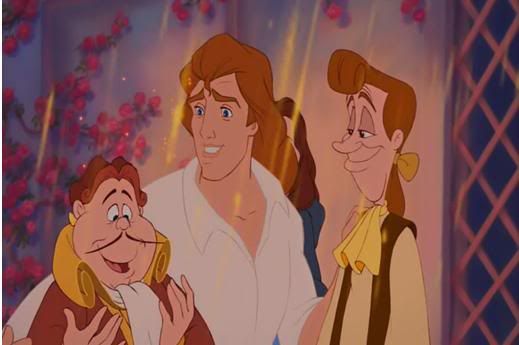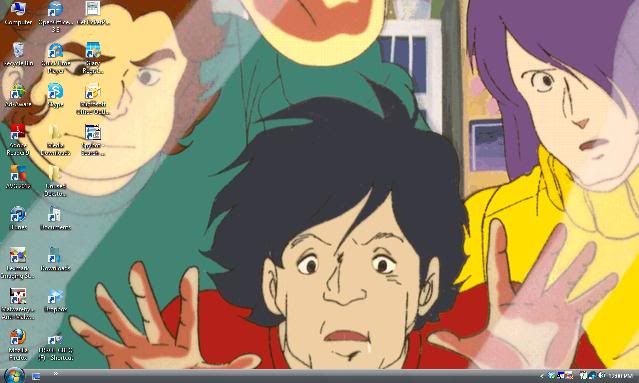
Though I love Disney's Beauty and the Beast, I can't get on board with the backlash against the backlash, the disdain for any attempt to describe the film as representing Stockholm Syndrome or metaphorical domestic abuse. Usually this rebuttal is that the film is about the Beast becoming a good person, and Belle never puts up with his shit, so that those who criticize the film's morality simply aren't looking at its contents properly.
That's not really the issue, though. The fact is, there's no way to intellectually "prove" that Beauty and the Beast is or is not about this sort of thing. Relating the specifics of its story or the intention of the writers will not talk viewers out of their gut reactions. Nor should there be any need to try: viewers ought to be open when a work disturbs them. It doesn't mean they want the work censored, or think it's actually bad: it might just creep them out in ways not intended by the people who made it.
Asking myself the question, "Does the plot of Beauty and the Beast unintentionally make me uncomfortable?", well, I love the film a great deal, because it is well-crafted in terms of plot and animation, has actual character development, and it's likable with good songs. I love the character of Belle, and the design of the Beast, and when they start falling in love, it feels very natural and true to the characters rather than a generic love story. But...I can't help but wince a little when I think about the conditions of the movie.
I can't get over the idea that when they start falling in love, Belle is still technically his prisoner. Sure, she's happy, and the Beast isn't getting a free ride, either--he has to learn to become a better person, and sets her free when she needs to go. But Belle is only there because she was imprisoned. I believe in the central romance well enough, but I just can't forget that. At the start Belle was terrified: she was crying, despairing, and so on. I can't forget it.
Fiction is funny because sometimes you're okay with witnessing things that would disturb you in the real world, and sometimes you aren't. No one can predict how they will react, and no one knows how to create a work so the audience will completely forget about the real world and look at the fiction only in terms of its "objective" creation and not their own values or experiences. Many viewers forget entirely about the real-world suggestions found in Beauty and the Beast and enjoyed the story as-is, but no one needs to apologize for a piece of fiction making them uncomfortable.
The particular backlash towards criticism of Beauty and the Beast, however, may be founded on how hard the film tries to make its potentially unsettling aspects presentable for a modern, egalitarian audience. Given the way popular art is designed to evoke emotions, Beauty and the Beast should not be attacked for trying to do this, but it can be studied as an expert way to create a movie that gets viewers to feel what you want them to feel, and render a potentially disturbing situation palatable.
I went briefly over the ways the film does this in my initial review, but I'm going to talk about the attempts again. The makers of the Beauty and the Beast were apparently cagey enough to understand that some might find the idea of a man trying to woo his prisoner unpalatable in the 1990s. So, they do the following:
Firstly, Belle, the heroine, is an egalitarian dream. She is strong-willed, intelligent, and adventurous. Giving her this strength makes it seem as though she is on equal footing with the Beast, and therefore there is no problem in what they do together.
A lot of us nerd girls also identified with her, and so we are even more willing to give her experiences the benefit of the doubt, lest we start seeing our empowerment fantasy as a simple victim instead. It ought to be a lot more complicated than that, since the Beast still has power over her, but I can see why Belle's characterization makes many people want to go with it.
As a particular example, Belle is technically in the castle of her own free will. She must stay, because she willingly gave herself in exchange for her father, whom the Beast had imprisoned. In the eyes of many viewers, Belle is less the victim because she acted for herself, and stays in the castle in part because she chooses to obey that obligation. Furthermore, she only starts to love the Beast when he realizes he must be nice to her and actually tries.
However, I don't forget that Beast had no reason to keep Belle there except the most mercenary one: here is a girl that could break my spell. The situation is treated as an awkward romance opportunity, completely ignoring the fact that Belle has no choice but to stay there. Perhaps in real medieval France, the Beast would also be obliged to keep her out of dishonouring the castle, but this being Disney, we can't assume historically-accurate values when not in evidence, and put the onus for Belle's freedom entirely on the Beast. Still, I can see why that part worked for most viewers, too.
Secondly, the film gives the Beast an even worse "beast" to play off. Enter Gaston, who actually and overtly does want to enslave Belle in marriage. Gaston is vain, callous, anti-intellectual and sexist. With him around, sticking his chauvinism right in your face, of course audiences are more likely to root for Belle and the Beast, because the disturbing stuff there is only subtextual and unintentional. Since Gaston is everything that a liberal-minded woman would hate, this also helps to explain why many progressive people would come to the defence of Beauty and the Beast while decrying similar works.
Thirdly, just gloss things over. When it comes to portraying the Beast, the film very speedily moves away from his initial threatening entrance to replace it with something more along the lines of grouchy and awkward. The scenes where the Beast appears bristling and cloaked in shadow are extremely brief, and his look also softens for the first time when he hears Belle's offer of exchange, which is very early in the film. The film is then ready to make the viewers sympathetic towards the Beast in earnest, to make them forget about that small period where he seemed truly monstrous.
After Belle is set in the castle, the Beast is portrayed as less a terrifying monster than a big, hairy man-child taking his first steps at an awkward courtship. He gives this impression that he is, if not yet likable, is somehow non-threatening. When he starts yelling at Belle's door to come down to dinner, no matter how loud Robby Benson is in that scene, one never gets the impression that he actually would break in and hurt Belle.
It makes some sense, since he was transformed basically for being a brat, but it's also a convenient way to defuse the audience's dislike of the scenario, by making them believe the Beast isn't that bad. It turns the narrative into "woman civilizes man-child" which has its own set of philosophical problems, but is also more benign than the "woman is successfully wooed by her monstrous jailer" angle.
Furthermore, by making the Beast's learning to be a nice person into the central character arc, viewers sympathize with him even more. Belle may be the initial viewpoint character, but it's Beast who goes through the most changes in the story; he is the protagonist, she is the love interest. Because we see him doing nice things for Belle without being prompted, starting with saving her from the wolves after he chased her from the castle for almost touching the enchanted rose, it is easier for the audience to forget that she is technically his prisoner. He loses his childish grumpiness and starts to try to love her in earnest, giving Belle gifts that cater to her interests and self, such as the castle's huge library. We love the Beast because he tries and succeeds to be good, and so it is harder and harder to think of him as a jailer. Just as with Belle's strength, the movie tries to redeem its scenario simply by moving away from the most black-and-white understanding of victimizer and victim. Most of us know intellectually that it's more complicated than this, but we are willing to go along.
Finally, Beast makes the decision to let Belle go when she sees her father lost in the woods: it might cost him his human form, but he loves her enough to do it. Very few, perhaps, could hold onto their objections after such an unselfish display. Introducing such a modern, progressive notion of love also further serves to soften viewers towards the situation the Beast created. After all, he really must see her as a person if he can let her go at this most crucial time, right? Of course, because it's held up as the ultimate proof of their love. Intellectually viewers know that if the Beast were a good person he never would have held her captive at all, but emotionally, one can be pulled in by an individual character's circumstances.
Another justification is not found in anything specific to Beauty and the Beast, but a general unspoken conceit in fiction: the most moral option may be one that would destroy the story as it was, and therefore the character must engage in suspect actions in order to further the plot. The plot proceeds because the Beast and his servants want to keep Belle there regardless of her desires, on the chance she may fall in love with him and break their curse.
Belle is not consulted and does not know their circumstances; if she did know about their plight, it would have killed the suspense of the romance if she agreed, or made it too dark if she disagreed. To some, this serves as justification for the actions of the Beast. If he didn't keep Belle captured, there would be no story, and so it is pointless to complain about his actions.
Yet it is not that easy for anyone to get rid of their instinctive reactions to a plot that hinges on this behaviour. No matter how hard Beauty and the Beast tries to frame a scenario where the actions of the title Beast are considered entirely justifiable, someone is going to be uncomfortable with it.
Like I said, it doesn't entirely work for me. It does because I enjoy the film, but it doesn't because I am still mildly uncomfortable with the main scenario. Still, whatever I do feel, the thorough and meticulous way the film tries to cast Beast and Belle in a palatable light while keeping true to the original prisoner motif is admirable in its craftsmanship. It makes for good product.
This does not mean viewers who feel disturbed by the film are "wrong" or just aren't taking into account the fact that the Beast needed to become a better person before Belle truly loved him. No, sometimes, whatever a story does, a viewer is disturbed by it.




